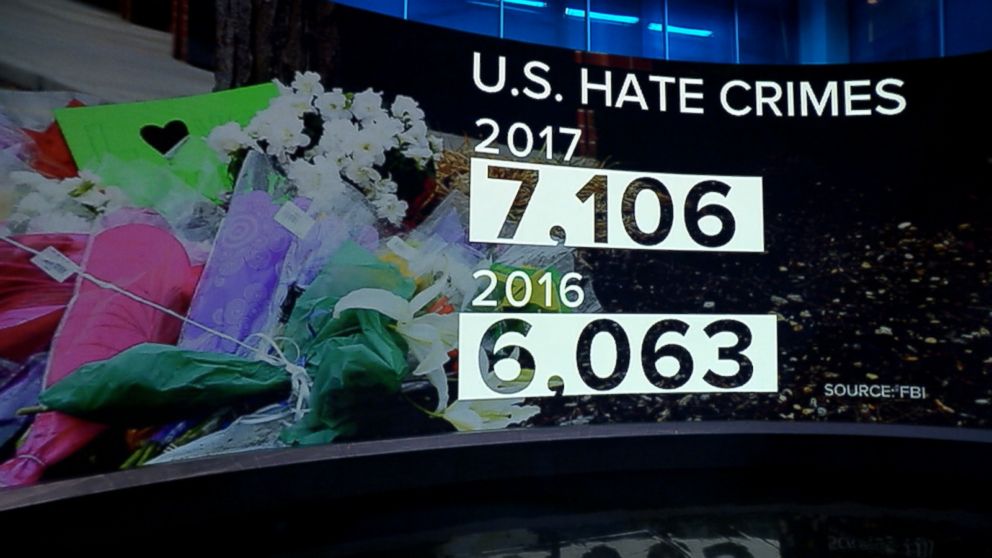WASHINGTON, D.C. — The Federal Bureau of Investigations released its Hate Crime Statistics 2018 report this week.
The report is the Uniform Crime Reporting (UCR) Program’s latest compilation about bias motivated incidents throughout the nation. The 2018 data was submitted by 16,039 law enforcement agencies that provided information about the offenses, victims, offenders and locations of hate crimes.
It shows that hate crimes against Latinos have spiked over those committed against Muslims and Arab Americans. Two hundred seventy hate crime incidents against Muslims and Arab Americans were reported to the FBI, though civil rights activists have pointed out that daily incidents of bullying and discrimination often go unreported to authorities.
According to the FBI, these law enforcement agencies submitted incident reports involving 7,120 criminal incidents and 8,496 related offenses as being motivated by bias toward race, ethnicity, ancestry, religion, sexual orientation, disability, gender and gender identity.
The UCR Program does not estimate offenses for the jurisdictions of agencies that do not submit reports.
Victims of hate crime incidents
The report shows that there were 7,036 “single-bias” or bias motivated incidents involving 8,646 victims.
Among the victims, 59.6 percent were targeted because of the offenders’ race, ethnicity or ancestry bias, 18.7 percent were targeted because of the offenders’ religious bias, 16.7 percent were victimized because of the offenders’ sexual-orientation bias, 2.2 percent were targeted because of the offenders’ gender identity bias, 2.1 percent were victimized because of the offenders’ disability bias and 0.7 percent were victimized because of the offenders’ gender bias.
There were 84 hate crime incidents in which the offender held multiple biases, which involved 173 victims.

FBI Hate Crimes Report

Offenses by crime category
Of the 5,566 hate crime offenses classified as crimes against persons in 2018, 46 percent were for intimidation, 34 percent were for simple assault and 18 percent were for aggravated assault. Twenty-four murders and 22 rapes were reported as hate crimes. The remaining 39 hate crime offenses were reported in the category of other.
There were 2,641 hate crime offenses classified as crimes against property. The majority of these (71 percent) were acts of destruction/damage/vandalism. Robbery, burglary, larceny-theft, motor vehicle theft, arson and other offenses accounted for the remaining 29 percent of crimes against property.
Two hundred eighty-nine additional offenses were classified as crimes against society. This crime category represents society’s prohibition against engaging in certain types of activity such as gambling, prostitution and drug violations. These are typically victimless crimes in which property is not the object.
Known offenders
In the UCR Program, the term known offender does not imply that the suspect’s identity is known; rather, the term indicates that some aspect of the suspect was identified, thus distinguishing the suspect from an unknown offender. Law enforcement agencies specify the number of offenders and, when possible, the race of the offender or offenders as a group.
Beginning in 2013, law enforcement began reporting whether suspects were juveniles or adults, as well as the suspect’s ethnicity when possible.
Of the 6,266 known offenders, 53.6 percent were White and 24 percent were Black or African American. Other races accounted for the remaining known offenders: 1.3 percent were Asian; 1.0 percent were American Indian or Alaska Native; 0.3 percent were Native Hawaiian or Other Pacific Islander and 6.9 percent were of a group of multiple races. The race was unknown for 12.9 percent.
Of the 5,349 known offenders for whom ethnicity was reported, 29.9 percent were Not Hispanic or Latino, 8.9 percent were Hispanic or Latino and 1.6 percent were in a group of multiple ethnicities. Ethnicity was unknown for 59.5 percent of these offenders.
Of the 5,589 known offenders for whom ages were known, 84.7 percent were 18 years of age or older.
Locations of hate crimes
Law enforcement agencies may specify the location of an offense within a hate crime incident as 1 of 46 location designations.
In 2018, most hate crime incidents (25.7 percent) occurred in or near residences or homes. More than 18 percent (18.7) occurred on highways, roads, alleys, streets and sidewalks, while 9.2 percent occurred at schools and or colleges, 5.3 percent happened at parking lots, drop lots and or garages and 3.7 percent took place in churches, synagogues, temples and mosques.
The location was reported as other/unknown for 11.2 percent of hate crime incidents. The remaining 26.1 percent of hate crime incidents took place at other or multiple locations.
Hate Crime Statistics 2018 is available on the FBI’s website at https://ucr.fbi.gov/hate-crime/2018






Leave a Reply